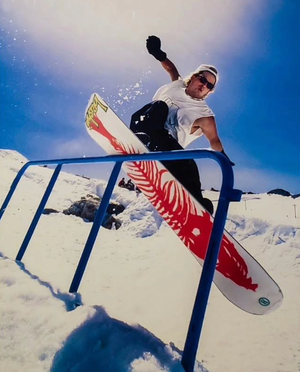Jeff Brushie and the Iconic Super Pipe as Told by Photographer Sean Sullivan
Apr 07, 2025

There are a few images that transcend action sports culture and burst into the mainstream. Climbing has Jimmy Chin's shot of Alex Honold standing on the ledge on El Cap. Skating has Rob McConnaughy's sequence of Tony Hawk's groundbreaking 900. And snowboarding has Sean Sullivan's photo of Jeff Brushie at the Super Pipe in Blackcomb. On the surface, Sean's Superpipe shot serves as a historical record of one of the most legendary days in 90s snowboarding. It was a day where the biggest and baddest halfpipe and the world's best riders came together for an undeniably memorable day of riding. It could be argued that Sullivan captured the first rail jam of its kind, though he'd never claim such an accolade. A deeper look at Sulli's Brushie image and its place in snowboarding history reveals its broader impact on snowboarding culture, which pushed the sport away from nineties' ski and snow culture towards counterculture and its skate roots. I connected with Sullivan while he was heading into the mountains to discuss the renowned Jeff Brushie Superpipe shot and its influence on snowboarding today.
Sulli's Path to Snowboarding Photography
The Super Pipe shot took place during Sullivan's second year as senior photographer for Snowboarder, but its influences and style can be traced to Sean's early days of shooting in the skate world. Sullivan snapped the Brushie photo with a 16 mm fisheye lens that had become synonymous with skate photography. Sullivan shares that he grew up in Orange County, stating, "I was a skateboarder first and moved over to snowboarding because money wasn't in skateboarding… I had aspirations to be a pro skateboarder… [but] I ended up busting my ankle really bad... I still wanted to hang out with my buddies, so my mom gave me a camera, and I started shooting. I realized pretty quick that I had a knack for it." Sullivan dove into shooting and soon sent photos off to Thrasher for publication. From there, he segued into snowboard photography and moved to Tahoe when he graduated high school in the fall of 89 and landed at Kings Beach on the North Shore. At that point, Sullivan became prolific, admitting, "I was shooting a hundred-plus days a year. I was 110% committed to documenting snowboarding at the time, eating, sleeping, breathing snowboard photography."
The Birth of the Superpipe
Sullivan points out that at the time, there was a stark divide in the snowboard editorial world between photographers from a ski background and those from a skate background. Ski background photographers typically shot with telephoto lenses or, as Sullivan calls it, "guy in the sky" photography. Those from a skate background preferred up-close action shots using fisheyes and wide angles that included a lip line. After a few years of submitting photos to Snowboarder, Sean was pulled into their senior staff. During his second year working full-time for Snowboarder, he pitched the idea of the Superpipe. Sean explains that the idea was to "build the best pipe we can and invite the best guys to see what they can do." He explains that the Snowboarder crew and a team of willing Canadians hand-dug the pipe. Fellow Snowboarder photographer Dano Pendygrasse helped set up, facilitate, and shoot the event.
Breaking Barriers in Blackcomb
The Superpipe attracted the who's who of nineties snowboarding, including Jamie Lynn, Shaun Palmer, and Jeff Brushie. The talent there was undeniable, and the shoot produced some of the most celebrated imagery in snowboarding history. As Jamie Lynn pointed out recently on his appearance on the FNRad Snowboarding Podcast, "It was wild. To get Brushie, Palmer, and myself together in one place doing things in a half pipe, integrating rails into a half pipe setting. [No one] had ever seen that before. I don't know who came up with that idea, but it was something that sparked off this whole generational genre of like, [what's possible] … What came out of it was something that [raised] the potential of what we could do."
Sean reveals the blue rail was actually a chairlift corral that the crew salted into the half pipe on a whim. We had one of the cats bring it up, and we salted [it] into the edge of the pipe, and those guys started ripping it." He points out that Brushie came from a skate background, and it showed in his approach. Brushie hit the rail, Sean got the shot, and the rest is history. What started as a bold idea at Snowboarder HQ became arguably one of the most impactful days in snowboarding history. It was a day that pushed snowboarding to embrace its skate roots, forcing the day's top riders to rethink what was possible and reshaping the industry entirely.
Check out Sulli's legendary shot and more here.

